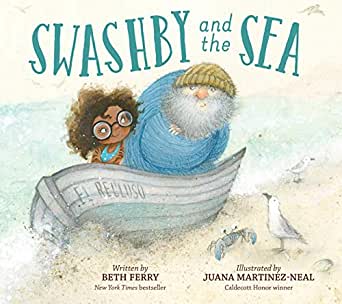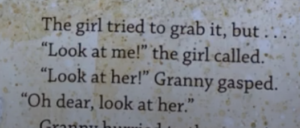
Why I Picked It Up:
I loved the illustrations by Juana Martinez-Neal! This book came across as a “what to read next” suggestion, and I was immediately captivated by the drawings.
Why I Finished It:
Even though the storyline is a bit predictable, the characters were intriguing. I love the interaction and developing relationship between the little girl and Swashby. Swashby is an isolated, arguably grumpy, old man, who lives by himself by the sea. He appreciates beauty and SILENCE. Alas, a little girl and her mother move in next door. With his life shaken, he leaves messages in the sand that are less than neighborly. Unfortunately for him, the sea wipes away enough of the message to make it a neighborly comment (so maybe it was fortunate for him). Following the directions left in the sand, the little girl winds up befriending Swashby.
Who I Would Give It To:
This sweet and humorous story with beautifully calming illustrations is perfect for our younger elementary students. There is lots to teach and enjoy with this book – see integration ideas below!
Integration Ideas:
Personification

This beautiful picture book brought the sea to life! Swashby and the Sea is a great tool to teach students what personification is, but remember to ask them why the author chose to use personification. This will help them understand what they are reading, as well as help them become better writers.
While there are many great responses, I believe the author used personification to further help the reader understand Swashby’s relationship with the sea and how he initially felt it was being disrupted by a little girl.
Alliteration and Word Choice
This text frequently uses alliteration that enhances the flow and rhythm of the story. Check this one out, “Squeaks and squeals sprang from the house next door”. My teacher heart just exploded!
What a beautiful sentence filled with imagery and all wrapped up in a beautiful bit of alliteration. I would use this mentor sentence with the students and allow them to close their eyes and listen, then listen and draw what they hear.
After several repetitions of the sentence while they draw, we would talk about what they visualized. We would examine the writers’ craft and use of alliteration. As always, ask why the author used this strategy.
Next, have students try to implement alliteration into their own writing. Here are a couple more examples from the text, “Neighbors were nosy, a nuisance, annoying.” and “Neighbors can be fun, and friends, and … family.”
Word Choice
And, let’s be honest, how many picture books designed for younger students do you know that use the word “commandeered”? The conversations we can have about this word are insane! My favorite way to show the power of word choice is to change the word. I would reread the sentence using the word ‘take’ instead of commandeered and ask how that changes the entire sentence. I play short video clips from movies where the word is used and we have a few-minute conversation on the importance of word choice.
Multiple Meaning Words
There is also a great sentence here to discuss multiple-meaning words, “The sea will see a wish come true”. Use this sentence to discuss the differences between the sea and see. Then give student pairs a multiple meaning word and have them write one sentence using both words and draw a picture to go with it.
Make Predictions
Making predictions is always a kid’s favorite thing to do while I read. It’s a fabulous skill to use and teach – just make sure that the students always go back to their predictions to confirm or adjust! This will force them to hone their skill, to really think about what makes the most sense given the text evidence and what they know.
Quite a few times in the story, Swashby writes an unfriendly message to the girl and her mom. However, on subsequent pages, the water washes away some of the messages to create something welcoming and fun. Have students make predictions on how the message will change prior to turning the page.
Pay special attention to the students who begin to realize the pattern of it constantly changing from negative to positive. Jot down the students who did not understand and pull them into a small group later to discuss this further.
Quotes – Dialogue
There is a lot of dialogue in this picture book! You can teach intonation, quotation marks, paragraphing dialogue, signifying speakers, different words for said, etc.









Leave a Reply